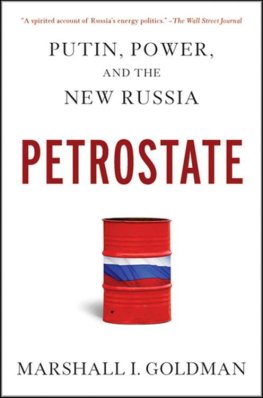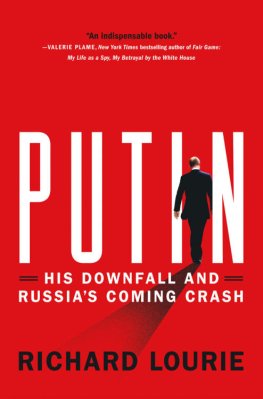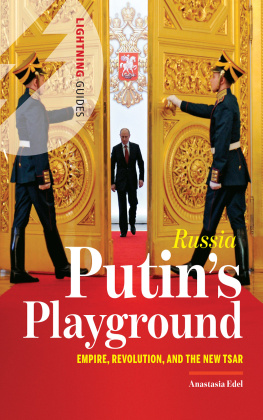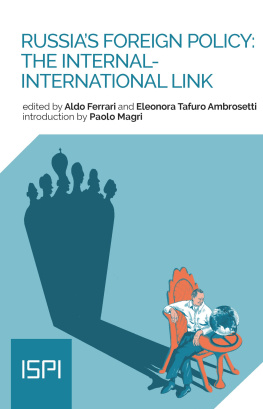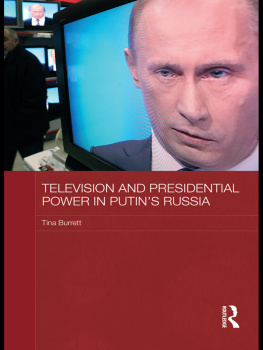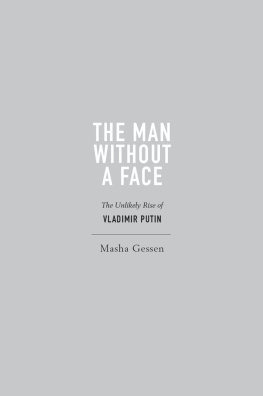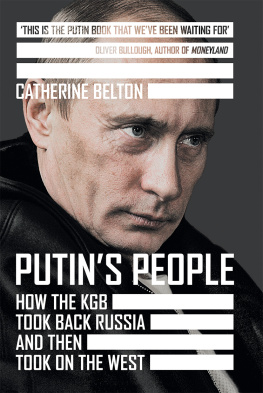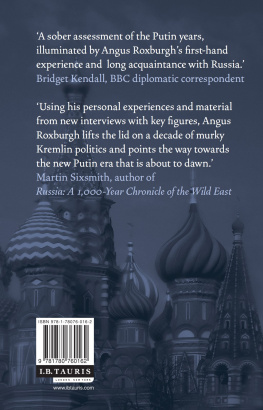Marshall I. Goldman
PETROSTATE
Putin, Power, and the New Russia
To Merle; not the First Dedication and I Hope not the Last
Preface to the Paperback Edition
Much has changed in the short time since Petrostate was first published in the spring of 2008. The price of petroleum, which peaked a bit later that summer at $147 a barrel, by winter plunged as low as $33. The drop in price and the resulting loss of revenue for Russia led my wife to comment that I should never have used Petrostate as the title of the book. With oil at $33 a barrel, Impoverished State would have been more descriptive. Besides, everyone was going to misread the title and wonder why an economist specializing on Russia and energy had written a book called Prostate. What did that have to do with Vladimir Putin? Did I know something about Putins health that his physicians had been hiding from the public?
She was right. Some readers did indeed misread the books title. Moreover, the collapse of petroleum prices, at least for a time, did crimp Putins swagger. The reduction in oil export revenues meant that the inflow of convertible currencies was no longer able to keep pace with the outflow expenditure of convertible currency spent on imports. As a result, a mere six months later, on March 31, 2009, Russias foreign currency reserves fell from nearly $600 billion in September 2008 to $384 billion (IMF update, April 23, 2009).
Of course the drop in petroleum prices was not limited to petroleum produced in Russia. It was part of a worldwide phenomenon precipitated by a slowdown in economic growth and, in many cases, even declines in GDP. Moreover, as petroleum prices fell in OPEC countries and Russia, where petroleum production can make up as much as 50 percent of the GDP, the drop in GDP was especially large. The result was not only a drop in export earnings but a reduction in government tax revenue and, equally important, in disposable income. In Russia, the consequent fall in consumer spending led to numerous factory closings, worker layoffs, and runs on banks.
The chain effect of the drop in petroleum prices hit Russia especially hard. Russian GDP in the first quarter of 2009 dropped 9.5 percent from a year earlier and fell even further in April 2009, declining by 10.5 percent compared to April 2008. This led to a 34 percent increase in unemployment over the preceding year. Simultaneously, prices rose 14 percentmeaning that in addition to its other problems, Russia found itself caught up in a bout of stagflation. If that were not enough to worry about, businesses fell behind in paying their wages, a periodic occurrence that the Russian economy has always had difficulty correcting.
The convergence of so many negative economic developments (something to make everyone worse off) triggered social unrest, even riots, especially when workers were laid off or were not paid in a timely way. One of the more dramatic examples took place in Pikalyovo, a small town south of St. Petersburg. In June 2009, 500 unpaid workers from the towns three nonferrous metal factories blockaded the main highway, causing a 250-mile traffic jam. Fearing this unrest might spread, Putin sought to blame the wage arrears on the irresponsibility and greed of the factory owner, Oleg Deripaska. Identifying himself with the workers, Putin demanded that Deripaska pay the workers what they were owed. Ranked by Forbes Magazine in 2008 as Russias richest oligarch, with a net worth of $28 billion invested mainly in the Russian aluminum industry, Deripaska had been badly hurt by the recession. Revising its estimates in 2009, Forbes reported that Deripaskas net worth had fallen to $3.5 billion, a loss of almost 90 percent. As painful as this must have been for Deripaska, by Putins reckoning Deripaska was not exactly a pauper either, although he was no longer Russias richest man. As Putin evidently saw it, with a little extra effort, and encouragement from Putin, Dereipaska could probably manage to scratch together enough to pay his workers their back wages. To increase the pressure on Deripaska, Putin arranged to confront him at one of the Pikalyovo factories, where by pure coincidence a TV camera crew just happened to be passing by. In a humiliating scene from the factory shown live on Russian TV and replayed around the world on YouTube, Putin berated Deripaska for his selfishness, conveying the message that it was the oligarchs like Deripaska, not Putin, who were responsible for Russias current economic decline. As a climax to their encounter, Putin then tossed Deripaska a pen and forced him to sign an order directing his staff to pay his workers their back wages. He signed.
Underneath the soap operalike drama at the Pikalyovo factory, there was a poignant irony. After abandoning communism and becoming a market economy, Russia found that it was particularly ill prepared to weather an economic slowdown. Recessions had never been a problem in the days of the Soviet Union. Maintaining economic growth in the Soviet centrally planned economy era was in many ways easier to do than it was in a market economy. Soviet central planners simply ordered factory managers to produce a certain quantity of goods without worrying whether or not there were customers for those goods. By contrast, after the move to the market economy, the Russian government and its central bankers have had to struggle to juggle a variety of indirect economic variables such as interest rates, money supply, and government expenditures as well as tax cuts and increases, in the hope that consumers and businesses will take the bait and increase or decrease their spending in tandem with the governments objectives.
Of course in actual practice, the USSRs previous system of central planning turned out to be much more complicated and less achievable than official Soviet state reports would have the outside world believe. For example, even when Soviet factory managers produced what they were ordered to produce (which was all too often not the case), there was no certainty that Soviet consumers would buy those goods, even essentials. This planning shortcoming occurred largely because it is not easy to predict consumer demand, even for basic goods for which the demand is inelastic and unlikely to change. In addition, the quality and variety of goods put on the shelves by Soviet factories often left much to be desired. No matter how desperate they might have been, many Soviet consumers refused to buy the shoddy merchandise often produced by Soviet factories. Consequently, goods were left on the shelves. As for nonessential products, where demand is dependent on what the consumer might or might not crave at the moment, gauging the right amount to produce, but no less nor no more, turned out to be a particularly challenging and rarely achievable quest.
Theoretically at least, proponents of central planning argued that there would be no such problems. As unpredictable as consumers, both individuals and businesses, might be, the prevailing communist ideology insisted that once central plans were adopted and factory managers knew how much and when they were expected to produce and how many workers they needed to employ, central planning would work better than a market system in capitalist countries where factory managers have even more difficulty determining the right amount to produce and the right number to employ. Since the planning system was supposed to work so well, central planners saw no need to introduce the measures designed to cope with economic downturns that many governments in market systems in the West periodically have been forced to adopt. These Western measures included what economists came to refer to as automatic stabilizers. A good example is how Western governments deal with unemployment. In a time of prosperity, workers wages are taxed and the proceeds put aside in a rainy day fund to be tapped should that worker ever find himself or herself unemployed. Such mechanisms reduce consumption in prosperous times, but in a recession, when there is almost always a jump in unemployment, it makes possible higher expenditures on consumption than would otherwise have been the case without such stabilizers. In other words, such mechanisms help temper extremes and thus stabilize the economy, keeping it on a more or less even keel.

